The AMD Llano Notebook Review: Competing in the Mobile Market
by Jarred Walton & Anand Lal Shimpi on June 14, 2011 12:01 AM ESTPower Gating
With 1.45 billion transistors on die, Llano relies on extensive power gating in order to keep things in order. The APU is split into two independent power islands: the CPU and the GPU. The memory controller and North Bridge both live on the GPU's power island. Each island has its own independent voltage source.
Everything from an individual CPU core to the entire GPU or virtually the entire APU package can be power gated. AMD provided photon recombination images to show the impact power gating the GPU can have on leakage current:
Although not depicted above, Llano can also fully power gate the x86 CPU cores or both the CPU and GPU if the entire APU is in a deep sleep state. Being able to completely power gate CPU cores or the GPU is an important part of enabling the next major feature of Llano: Turbo Core.
Turbo Core
All processors whether CPUs, GPUs or APUs have to be designed to strict thermal and power limits. OEMs need to know exactly what sort of chassis they'll be able to build around these chips and as a result the chip vendors provide guidance in the form of specifications, including the chip's thermal design point (TDP).
In the old days of microprocessors things were simple. You had a single core that ran all the time and it consumed all of the available thermal budget allocated for that core. AMD and Intel eventually enabled dynamic clock frequencies which let your single core underclock itself when it wasn't being used, which helped reduce power and extend battery life. Then came the multi-core era.
CPUs couldn't just start putting out twice as much heat now that they had two cores; instead, each core had to consume less power. The chip guys achieved this by running the cores at lower frequencies and voltages than they did in the single-core days. Two cores paved the way to four cores, which meant another reduction in clock speed per core. Sure we got much better multi-threaded performance, but for single-threaded applications performance wasn't as great as it could be. Users had to make a tradeoff: good multi-threaded performance or good single-threaded performance; you couldn't have both. Until power gating came along that is.
Without power gating you can never really shut off power to an idle core. The transistors aren't switching but power is still dissipated thanks to leakage current. Remember that transistors don't simply stop conducting electricity when they're off. The smaller they get, the more leaky our beloved transistors become. Power gating lets you physically block the flow of current to the transistors that are being gated, so when they're off, they're actually off. With an idle core shut off, now you have the extra TDP headroom to run any active cores at higher frequencies.
Intel does this with a technology it calls Turbo Boost. Intel looks at current draw and thermal sensors spread out all over the chip and determines when it has the available thermal headroom to turbo up any active cores. AMD implements a similar technology in Llano (and previously in their hex-core desktop parts) called Turbo Core.
I say similar but not identical because AMD's approach differs in a very important way. While Intel looks at current draw and temperature data, AMD looks at workload. Each activity within the Llano APU is assigned a certain power weight (e.g. an integer multiply is known to require a certain amount of power). Llano is aware of the operations it's currently working on and based on the weights associated with these operations it comes up with a general estimate of its power consumption on a per core basis. I mention this is an estimate because it correlates digital activity to power consumption; it doesn't actually measure power consumption.
Based on the number of events and their individual weights, AMD estimates the power consumption of each core and determines how much TDP headroom exists in the system. If the OS is requesting the highest p-state from the CPU and there's available TDP headroom, Llano will turbo up any active cores up to a maximum frequency. Like Sandy Bridge, Llano is able to temporarily exceed the APU's maximum TDP if it determines that the recent history of power consumption has been low enough that it'll take a while for the APU to ramp up to any thermal limits.
One major limit of Llano's Turbo Core is that the GPU can't turbo up in the event of the CPU cores being idle. Only the CPU cores can turbo up if they have available headroom. I suspect future versions of Llano will probably enable GPU Turbo Core as well:
It's unclear to me at this point what shortcomings or advantages exist for AMD's Turbo Core method vs. Intel's Turbo Boost. At the bare minimum the two are finally comparable although they use different approaches to attain a similar end result. AMD doesn't yet have a method of actually displaying Turbo Core frequencies, unfortunately, so we're operating a bit blind at this point. Over time I hope to have a better idea of how AMD's solution stacks up.


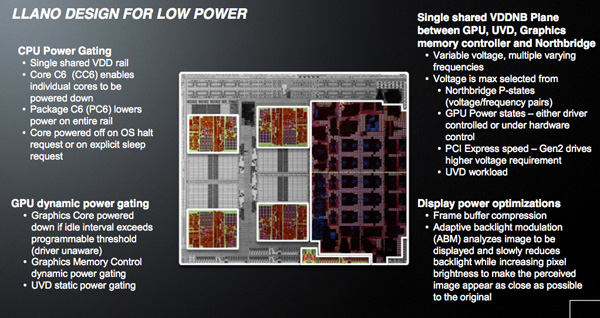
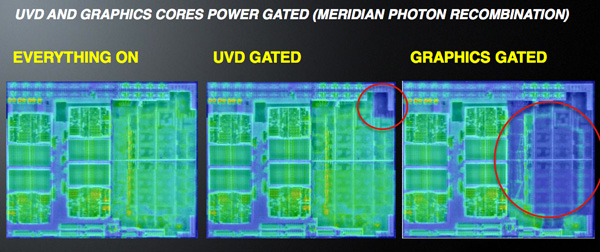
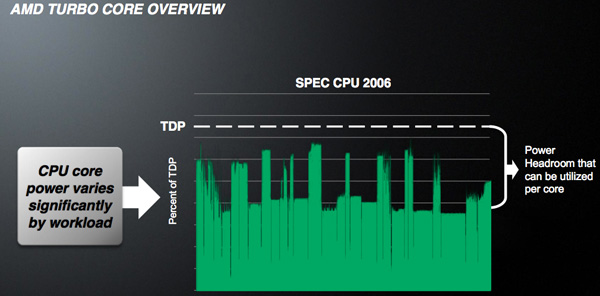
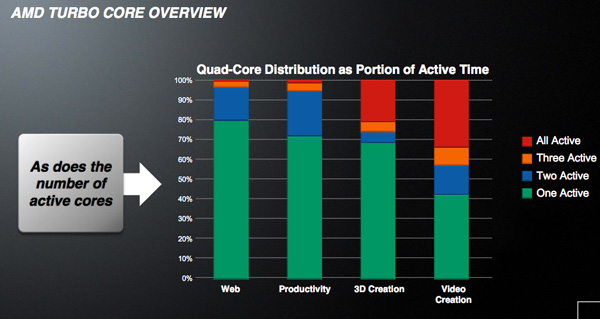
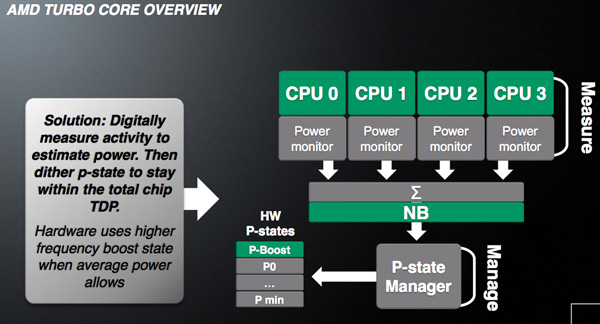
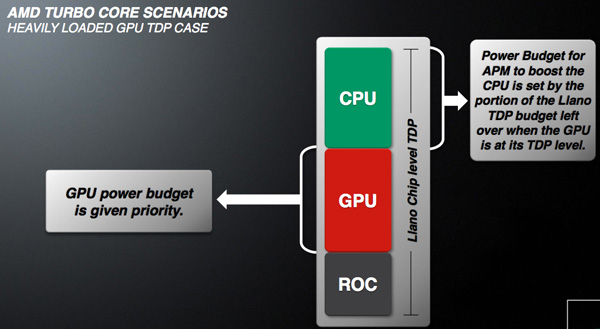
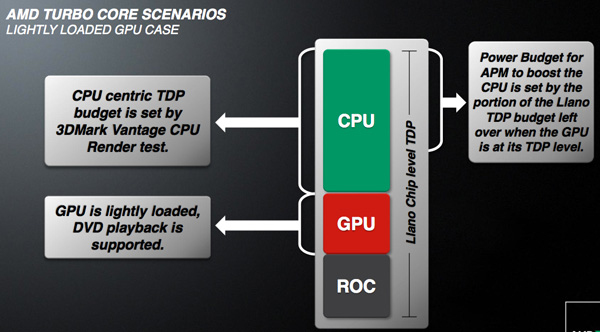








177 Comments
View All Comments
JarredWalton - Tuesday, June 14, 2011 - link
Totally agree with the pricing. The highest performance A8 laptops are going to need to be $700 with fGPU only, and maybe $800 with dGPU, because that's where dual-core i5 + Optimus laptops are currently sitting.Of course, I'd still pay more for good build quality and a nice LCD and keyboard.
Oh, and the people saying CPU is the be-all, end-all... well, even though I have a couple Core i7 Bloomfield systems in my house (and many Core i5/i7 laptops), my primary work machine is running... Core 2 QX6700 (@3.2GHz) with an HD 5670 GPU and 4GB RAM. The area I want to upgrade the most is storage (currently using RAID0 Raptor 150GB), but I have no desire to reformat and start transferring apps to another PC, so I continue to plug along on the Raptors. This CPU is now over four years old, and yet the only thing I really don't like is the HDD thrashing and slow POST times.
ionave - Thursday, June 16, 2011 - link
None of those GPU's match the power of the 6620, which you can find in even the A6 series, so your point is invalid.Dribble - Wednesday, June 15, 2011 - link
Actually you can normally tell quite easily which laptop has the slower cpu. It's the one with the fan whining away. With laptops having a more powerful processor that isn't having to work so hard is important just to keep the thing quiet.As for cpu power - well windows and it's software just isn't that efficient. Even a fairly complex word 2010 doc (few pictures/charts/etc) can start to feel slow on a 2.5Ghz C2D (I should know my laptop has a 2.4Ghz C2D). The flash games my kids seem to be forever finding are also cpu only and will run it flat out and the game won't seem as smooth as it would on a faster machine.
Sure you can get by with a slower machine, but it doesn't make for such a pleasant experience.
It has been the case since PC's arrived that over time software needs more and more power. e.g. I could run word 6 on a 486, I now really need a dual core 2Ghz machine to even run word 2010. I don't see that changing hence the faster your cpu the longer your pc will remain usable.
lukarak - Wednesday, June 15, 2011 - link
I've been using a 2007 tech MacBook white up until a few months ago with a 2.0 GHz C2D. Over time i upgraded it to include 6 GB of memory, a 64 GB SSD + 500 GB HDD, and then i transitioned to a 2011 MPB 13 with a SNB CPU and 4 GB of memory. Aside from a better screen, once i put in the SSD, i couldn't see the diference in speed. I usually use a lot of VM, use Eclipse and XCode, and most of the time watch 720p and the more than 3 years newer CPU isn't all that revolutionary. Sure, it may not use 30ish % of the CPU to play movies, but only 20ish, but until that's 50ish% when the fan gets louder it doesn't really matter for me.ionave - Thursday, June 16, 2011 - link
The CPU looks relatively slow to the i5/i7, but its really not that slow. Seriously. Compare it to an atom and see that its not that bad.ionave - Thursday, June 16, 2011 - link
The CPU isn't even bad. I don't know what you guys are all on but A8 cores are improved phenom II x4 cores... I would say its about the same performance as the i5 series. All the benchmarks online are measured on the WORST A8 chip, which has the worst CPU performance. All of the reviews are on A8-3500M. Just wait until the A8-3850 gets benchmarked.All I'm saying is that its not fair to compare the worst A8 to the best i5 or best i7, plain and simple.
sundancerx - Tuesday, June 14, 2011 - link
for most of the charts, yellow bar is assigned to INTEL asus k53e(i5-2520m+hd3000), but on asymetrical crossfire, this is assigned to AMD llano (18-3500m+crossfire). kind of confusing if you dont pay attention or am i the one confused?JarredWalton - Tuesday, June 14, 2011 - link
Dark yellow = K53E, bright yellow = CrossFire. If you have a different color you think would work, I'll be happy to change it. Purple? Brown? Orange?adrien - Tuesday, June 14, 2011 - link
I agree Brazos looks less interesting now but it still has one huge advantage: price. If Llano notebooks are going to sell for $600 (or $500), Brazos are 40% less expensive.JarredWalton - Tuesday, June 14, 2011 - link
Brazos E-350 (which is already 60% faster than C-50) start at around $425. They come with 2GB RAM and a 250GB HDD. AMD is saying $500 as the target price for A4, $600 for A6, and $700 for A8, but I suspect we'll see lower than that by at least $50. So if your choice is Brazos E-350 for $425 or Llano A4 for $450, and the Llano packs 4GB RAM and a 500GB HDD, there's no competition--though size will of course be another factor. I figure Llano will bottom out at 13.3-inch screens where Brazos is in 11.6" and 12.1". Personally, I'd never buy a 10" netbook; I just can use them comfortably. I'm happiest with 13.3" or 14" laptops.